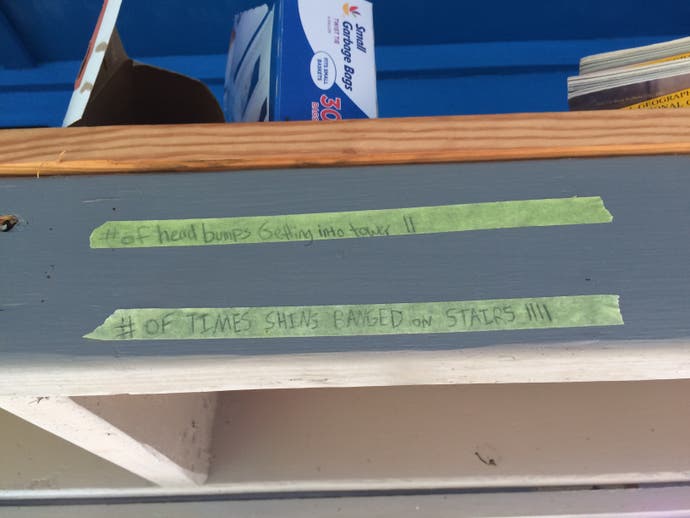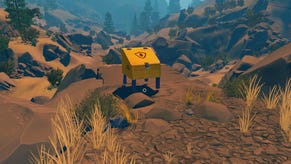How Firewatch helped a 14-year-old save a historically important tower
Firewatch with me.
Jack Kelley and his father are standing in the middle of the woods in Phillipston, Massachusetts. The pair are taking photos of the nearby fire lookout tower when, suddenly, they are approached by a stranger. As she closes in, they see that she is holding a lead in each hand - attached at the end of each lead is a goat.
"She has her two pet goats with her and she is telling us about how the government is spying on her using the fire tower," Kelley tells me. "I start walking away because she won't leave. So I just leave my dad there talking to her. That was good, because it allowed him to escape."
None of this would have happened in a world where game developer Campo Santo didn't make Firewatch, its 2016 indie hit about isolation, estrangement and scanning the horizons for signs of fire. The pastel-coloured, heartrending adventure impacted Kelley's life in more meaningful ways, too.
Kelley was 12 years old when he played Firewatch for the first time. Sitting in his bedroom in Hadley, Massachusetts - a small farming town in New England - he knew he was playing something special. The game's story resonated, but the experience also ignited a passion for something else: fire towers.
"Firewatch was the catalyst for my interest in towers," Kelley, now 14, explains. "It's not really one thing about them - it's their location, their history, and their design [I'm interested in]. After playing Firewatch - the ending at the Thorofare Lookout, which is an L4, and Henry's tower, the Two Forks tower - I just kept thinking about the design, how cool they look, and how cool it would be to do that kind of thing."

While Firewatch may not feature any goat herders, the story alludes to government conspiracies, aliens, and spies. In the end, all these quirks turn out to exist only in protagonist Henry's head; it is secretly a game about coping with guilt, and the paranoia of living in isolation. This grounded story was still bouncing around in Kelley's mind days after the credits rolled, but his real fascination was with the architecture.
"There wasn't a big gap in time from me finishing the game to heading out and looking at lookout towers [in real life]," Kelley recalls. "I've been to a lot of towers. A lot of the ones in Massachusetts are still active, so they're not really open to the public. The cabs at the top of them are usually locked because vandalism is one of the biggest problems."
Firewatch nails this. You spend a good portion of your time tracking revellers through Shoshone National Park; you find their empty beer cans, you clean up after them, and you try prevent them from doing any damage to the forest and your supplies. Likewise, the section where you follow a phone line to find a breakage is also an accurate depiction of the firewatch profession in the 1980s.
"That used to be something lookouts were required to do," Kelley explains. "There were some places in Maine where it was your job to check 15 miles of phone line to see if there was a break in it. That's a horrible job. Sometimes lookouts would spend whole days following the lines to find a tree branch had dropped on it."
Kelley's young brain is packed with trivia like this. On his bedroom wall is a board filled with information, including types of towers, what makes them unique, and even a list of the names of the lookouts who were stationed at different towers at certain times. Since he started travelling to visit firewatch towers, he and his father have visited over 140 of them - an average of more than one per week. It is no wonder he knows so much.
"Sundays are usually when I visit towers," Kelley says. "We get up early, my dad drives, and I usually do the planning. If we want, we can drive two hours to Vermont, do a nice hike there, then snag an easy-to-reach Massachusetts tower on the way back. It's usually not much hassle to do more than one in a day. We also do some overnight trips. The longest trip we've done was, like 1,180 miles, going from Massachusetts to Maryland. I think we did 15 towers that weekend. I'm really thankful to my dad for being willing to do that."
The first tower Kelley visited was Mt. Massaemett at Shelburne, Massachusetts. "It's still one of my favourite towers - but I don't really have favouri...," he trails off. "Well, I do," he laughs. "It's a wonderful stone tower that was built in 1911 for private use, and then the state took it over in 1913 to use as a fire tower. It's now one of the oldest still active in the United States."
That passion and in-depth knowledge of the towers has already landed Kelley voluntary work with the Forest Fire Lookout Association (FFLA). He runs the local Facebook page for the organisation and has even become good friends with the FFLA's eastern director.
"It's a voluntary organisation, the FFLA. I research, I go through archives, email people, get in touch with the Department of Conservation and Recreation," Kelley explains. "I have found towers the FFLA didn't know about, I've spoken to people and got a lot of stories from former observers."
These stories have given him a deep knowledge of not only the towers but also the occupation, even down to inconsequential quirks of the trade. In April 2017, Kelley and his father visited an active tower close to where they live. Inside they saw a tally etched into the wood. It said, 'Number of head bumps and number of knee bangs on the tower door'. Head bumps were already up to seven, and it was only the second day of fire season. Perhaps these small details are not so inconsequential after all.

Kelley's work, ultimately, is about saving towers. He sees them as historically important sites, rather than just buildings that exist to perform a function. Towers are often scrapped for parts and sold off. Some of them are converted into towers to carry mobile phone signals. One particular tower in Powellville, Maryland, was marked for death last year, and Kelley was determined to save it.
He had already missed the deadline to make a case to the Maryland Historical Trust for it to be preserved, but that did not stop him. He researched the tower and put together some documents highlighting its unique properties. This particular tower was an Aermotor LS-40 - on average, these are 60 feet tall. This one, however, was 145 feet tall, and was actually the tallest tower east of Mississippi.
After reading his pleas, the trust got back to him to brainstorm ideas on how the tower could be saved. They came to an arrangement. Now, the tower is not going to be scrapped for parts - instead it will be carefully taken down, stored for a while, and either partially or fully erected somewhere else as an attraction for people to visit.
"It's because of the people at Campo Santo that I'm doing this," Kelley says. "Firewatch happened to be at the right place at the right time."
Unfortunately, Kelley himself may be in the wrong place at the wrong time. His ultimate dream may never be realised. Towers are being disassembled all over the U.S., funds are being cut, and the country is leaning on technology to give out fire warnings instead of relying on lonely lookouts. Still, this clever teenager looks to the future with bright optimism and a laser focus.
"My dream would be to work as an observer in a tower," Kelley admits. "I'm not counting on that, though, because I'm not sure how long towers are going to realistically last. Since the 60s they've been declining in usage. So my plan is to tailor my education to become best suited for a job as a National Forest park ranger. Because even if I can't work as a lookout, I can at least be around them."









